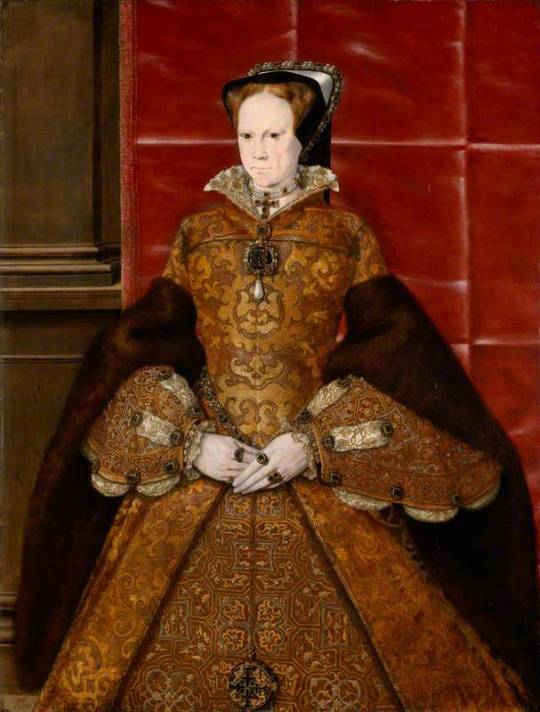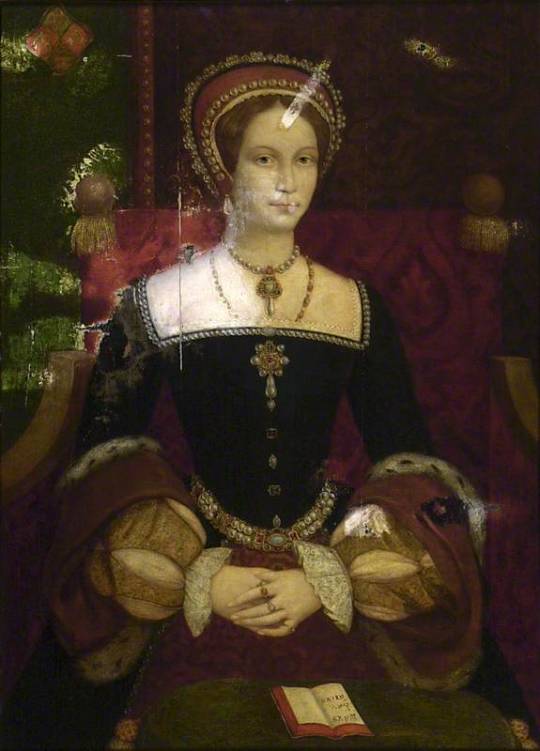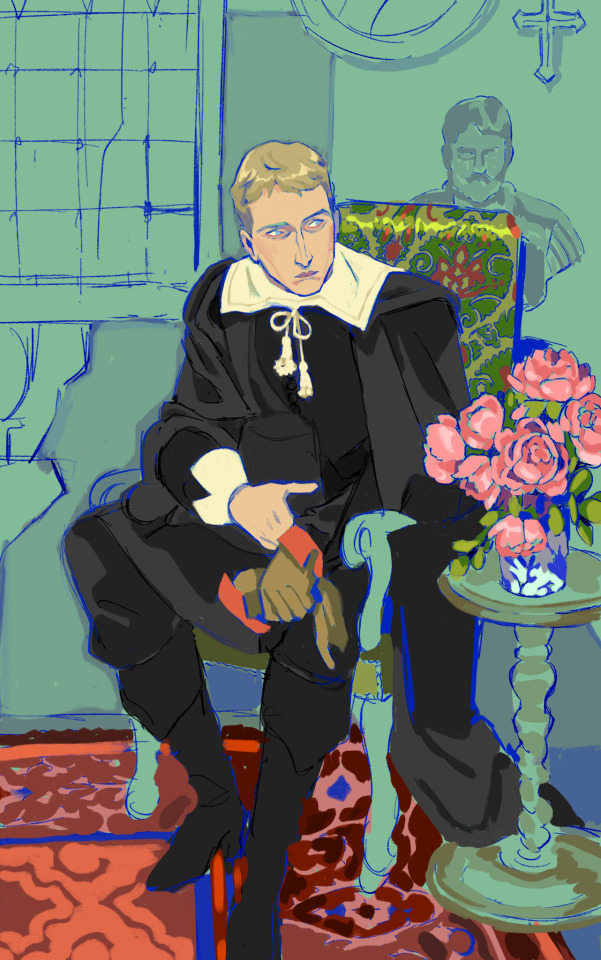#john francis mordaunt
Photo




A study of the rise of Mary Tudor as Queen of England.
“On the 4th July 1553, two days before Edward Vi's death, Mary "set out secretly from Hunsdon" in Hertfordshire and travelled to Sawston Hall in Cambridgeshire, the home of sir John Huddleston. Two days later her party moved on to the earl of Bath's house in Suffolk, Hengrave Hall. They reached lady Burgh's residence, Euston Hall, near Thetford, on the 8th July.
There "she was told of the king's death by her goldsmith, a citizen of London, newly returned from the City", and on "this account she stayed there no longer, but hurried on to her house at Kenninghall". The news was confirmed by Doctor John Hughes and Mary decided to challenge the duke of Northumberland for the throne. [...]
She was accompanied only by her household servants, numbering no more than sixty, according to Robert Wingfield. Among the principal members of her retinue, Robert Rochester, Edward Waldegrave, sir Francis Englefield, Henry Jerningham, and her secretary John Bourne, only one was a knight.
On the 9th July she sent to the council in London, commanding their obedience and proclaiming herself queen. Simultaneously she sent out letters "in all directions to draw all the gentlemen of the surrounding countryside to do fealty to their sovereign".
Sir Edward Hastings was ordered to support her in Middlesex and Buckinghamshire. Within three days she had been joined by the earl of Bath, sir Thomas Wharton, sir John Mordaunt, sir Richard Southwell, sir William Drury, sir Edmund Peckham, Thomas Morgan, Richard Freston, Ralph Chamberlain, Robert Strelley, and others.
Sir John Huddleston while on his way to Mary encountered Henry Radcliffe, one of the sons of the earl of Sussex, carrying letters to London from his father. He was conveyed to Mary and soon the earl of Sussex, sir Thomas Wharton's brother-in-law, had also joined her. On the 12th July she moved over the Suffolk border to the castle of Framlingham, joined en route by sir Thomas Cornwallis.
The same day Norwich, which had initially refused to open its gates to her messengers on the 11th, became the first town to declare for Mary. Henry Jerningham on the 15th heard of six ships (sent by Northumberland to prevent her escaping to the continent) lying off Great Yannouth. The town had committed itself to Mary after its municipal representatives had witnessed her proclamation in Norwich. By the time he arrived in the town the captains had rowed back aboard.[...]
The ships furnished Mary's swelling ranks of supporters with ordnance. The areas around her Hunsdon residence in Berkshire, Buckinghamshire, and Oxfordshire provided substantial numbers under sir Thomas Wharton, sir Edmund Peckham, and lord Hastings. (Hastings was said to have brought over a force of 4,000 troops from Middlesex and Buckinghamshire.)
The fact that within days of her letters, she had been joined by gentry with armed and provisioned retinues and that even before this happened she sent to be proclaimed in London, provides powerful evidence to support the suggestion "that Mary had lined up her loyal followers in readiness in these areas... well before Edward's death"
Northumberland left London through Shoreditch on the 13th July and reached Cambridge with an army of about 3, 000 by the 16th. He had followed the strategy in his Letters Patent, appealing to xenophobia in the light of anxieties about female authority by invoking the fear of greater foreign influence or invasion. At 7pm on the 16th in London the gates of the Tower "upon a sudden was shut, and the keyes caryed upp to the quene Jane".
Two days later a dozen of the Councillors locked up in the Tower (the earls of Bedford, Arundel, Pembroke, Shrewsbuiy, and Worcester, lords Paget, Darcy and Cobham, Cheyne, Cheke, Paulet and sir John Mason) slipped away from the Tower to the earl of Pembroke's residence at Baynard's castle. There they were joined by the mayor and certain aldermen.
A proclamation for Mary was drawn up and then two heralds, around 6pm on the 19th were sent into London to St. Paul's Cross in Cheap. [...] Disunity in his {Northumberland’s} army had already led to the defections of lords Howard and Grey, and when on the 18th, as he moved towards Mary's army, the news of the earl of Oxford's defection reached him through Henry Gate, he retreated to Bury and then to Cambridge. There he learnt on the 19th that London and the Council had proclaimed Mary in his absence. Northumberland published the Council's proclamation himself the next morning.
Lord Paget and the earl of Arundel arrived on the 20th at Framlingham with a letter from the council and the mayor and aldermen's London proclamation of Mary, to offer their submission. The earl of Arundel was sent to Cambridge the following day to arrest Northumberland, whose army had already begun to disperse and who had been belatedly surrounded and incarcerated by the mayor.
Contemporary chroniclers believed that her victory was the result of her popularity. One observer, the Spaniard Antonio de Guaras claimed: "es de marauillar el amor que este pueblo tiene a esta Señora que cierto offenden a nuestro Señor en ello porque le dexan de querer y la adoran". [...]
The provincial rising's success against central government had relied on the support of middle-ranking gentry in the counties, several of whom had connections with the fallen Howards. Mary's local support can not be explained though, as that of an 'out' faction, excluded from the patronage of the regency government. It was, however, Catholic and conservative: "activists in Mary's coup were Catholic nobles and gentlemen". In Norfolk alone of fourteen magnate families, the two who backed her, sir Henry Bedingfield's and sir Robert Southwell's were both strongly Catholic.
“The list of those swearing loyalty to Mary during these early days, like the list of those receiving rewards for service at Kenninghall and Framlingham, contains catholic name after catholic name... when in 1561 Dr. Sanders composed a list of catholic gentlemen who were suffering as a result of the accession of a protestant monarch it bore an uncanny resemblance to the earlier list of those rewarded in 1553: Browne, Waldegrave, Hastings, Sir Thomas Wharton, and Sir Thomas Mordaunt.
No nobleman sympathetic to protestantism supported Mary, and most of those who came to her aid were committed catholics. Thus the earl of Derby, for example, had opposed the religious changes of Edward's reign, Lord Dacre, who marched south to join Mary, had voted in the House of Lords against the 1549 Prayer Book and was to remain a catholic in Elizabeth's reign, and Lord Windsor, who assisted Hastings in proclaiming Mary in Buckinghamshire, had persistently voted against the religious innovations of the previous reign. Thomas West, Lord Delaware, had opposed the Edwardian Prayer Books as he had earlier opposed the dissolution of the monasteries. The earl of Bath, although he played little part in public affairs in Edward's reign, had voted against the bill for the marriage of priests.”
A contributory factor in her success may have been the brutal suppression by Northumberland four years earlier in 1549 of a serious popular rising in Norfolk - Keft's rebellion. This was one reason, which had persuaded Northumberland to take the field in person: "because that he had atchieved the victory in Norfolke once already, and was therefore so feared, that none durst lift up their weapon against him".'°° Fear of Northumberland may have driven some Norfolk towns into the arms of the Marians. This can not account for her proclamations' success elsewhere, in defiance of the government.
The coup's allegedly popular character ("noblemen's tenauntes refused to serve their lordes agaynst quene Mary"),'°' the notion that an act of national judgement swept her to the throne, ignores the role of municipal hierarchies. News of the scale of the risings in the provinces was instrumental in persuading peers on the Council to desert Northumberland. Although the struggle centred on East Anglia, the region of Mary's affinity, it also enjoyed key backing elsewhere; in Oxfordshire (where sir John Williams proclaimed Mary), Buckinghamshire (where sir Edward Hastings and lord Windsor did the same), and the Thames Valley: "the queen learnt from her scouts, who were ranging far and wide, that the people of Buckinghamshire, Oxfordshire, Berkshire and Northamptonshire were in arms and supported her cause".'°
In other parts of the country the earl of Oxford (allegedly persuaded by his household servants), lord Rich, the earl of Derby and lord Dacre (in the north), sir Thomas Cheney and sir John Gage marshalled support.'° In Wales where Mary had resided as princess of Wales from 1525-1 533, in Denbigh and Beaumaris, the Northumerland adherents Ellis Price and Richard Bulkeley declared lady Jane Grey queen and Mary a traitor. These decisions were quickly reversed and the "lies of Beaumaris" were denounced by the bard Siôn Brwynog: the country "wished for its welfare", "judging her to be Queen".'°
Others welcomed the "genial Queen from the heart of Gwynedd with her fortunate face" and the "silencing [of] those Saxons".'°The pleasure and fidelity of the Welsh, at the victory of the 'Welsh' Tudor dynasty reflected an affinity for their countrymen. In London on the 19th, in contrast to the silent reception of the herald's proclamation of Jane, Mary's had been received joyously: "The bonefires weare without nomber, and what with showtynge and crienge of the people and ringinge of the belles, theare could no one heare amoste what another sayd, besides banketyngs and synging in the street for joye".'°Another anonymous London chronicle recorded similarly that "the Joye whereof wonderfull for some caste money abrod, & some made bonfyars thorowe the whole cyte: the prayses were geuen to God in the churches with te deum & orgaynes, belles ryngynge & euery wher the tables spredd in the stretes, meate & drynke plentye, wyne geuen ffrely of many men".
The ringing of bells was a symbolically Catholic mode of expression. Bells had been being exported (cf. Thomas Pery, p.3) and taken down since the 1530s. Diego de Azevedo, resident in London at the time of the accession crisis, described Mary's victory:
“La Infanta Maria hermana del Rey muerto, sabida la muerte de su hermano, se fue al [...], y alli se fueron para ella todos los mas principales del reyno, y de alli se vino al paso de concetayna, y hizo muy breuemente mas de treinta mu hombres, y con ellos se vino la buelta de Londres.
Sabido esto por los del reyno, todos se alcaron por ella, y tomaron en prision al Duque Baurique, y al rey, y ala reyna nuevamente eligidos, y abs demas que eran en su favor y la Reyna Maria, (digo de Inglaterra) entra oy dia, que esta escribo, o mañana en Londres, a donde luego sera jurada, y cortara las cabecas a todos, ecepto ala reyna, que fue eligida, que desta dizen que auido piedad; y la reyna, y el reyno queda todo pacifico.
Por cierto que parescen cosas increybles estos acontecimientos, los quales yo creo que no pueden acaecer en ninguno reyno. La reyna es cristianissima, y asi la ha ayudado Dios: bo primero que haze es tomar la fe Catholica en su ser, como de antes: tendra poco que hazer en ello, porque los mas de los erejes, lo eran mas de miedo del Rey, y Protetor, que de sus voluntades. Prosperos succesos han sido todos para su Mag. y el mas prospero es que tiene salud y trata negocios.'°
According to Azevedo's account, the key to her success had been 'todos los mas principales del reyno' declaring for her and persuading the whole kingdom to rise up 'por ella'. Even the partisan Azevedo recognised that Mary's victory was not a triumph of Tudor legitimism.
[...] After her proclamation in London on the 19th, "that same nyght had the [most] parte of London Te Deum, with bone-fyers in every strete in London, with good chere at every bone[f'er], the bells ryngynge in every parych cherch".'°The credibility of this evidence is supported by the fact that the so-called Tower chronicler is believed to have been a reformer and adherent of Jane Grey. The story of Mary's accession is perhaps powerftilly suggestive that her Catholicism played a greater role in her success than is credited.
At Ipswich Mary was presented with a golden heart inscribed 'the heart of the people'. She visited her father's palace of Beaulieu at Colchester, sir William Petre's residence, Ingatestone Hall in Essex, Pirgoe, and then Havering. Finally she made her entry into London on the evening of the 3rd August 1553: the "nomber of velvet coats that did ride before hir, aswell strangers as others, was 740; and the nomber of ladyes and gentlemen that folowede was 180″. She was accompanied by her half-sister Elizabeth "and a grette company of ladys wyth hare", the guard and "after them Northampton and Oxfordshire men, and then Buckinghamshire men, and after them the lordes' servants; the whole nomber of horsemen weare esteemed to be about 10,000. A central place was given to the men from the counties who had been key in her success. At Whitechapel "the mayer with the aldermen reseved hare, and he delyveryd hare the swerd, and she toke it to the erie of Arnedelle, and he bare it before hare, and the mayer the masse [mace].”
Three political prisoners, symbolic of the religious and political reversal represented by Mary, were released by her when she reached the Tower; Thomas Howard, duke of Norfolk, Edward Courtenay, marquis of Exeter, and Stephen Gardiner, bishop of Winchester. The conservative Howard had been imprisoned when it had become clear that Henry Vifi was dying; a victim of the reformed faction which came to power with Edward's accession. He had remained in prison throughout the young king's reign. Courtenay's father had been a victim of Henry's decision in 1538 to eliminate all living members of the Plantagenet line and had spent most of his life in prison. Gardiner had been committed to the Fleet on the 25th September 1547, for his protest at the issuing of the First Book of Homilies on the 31st July.[...]”
Quoted from: SAMSON, Alexander Winton Seton.“The marriage of Philip of Habsburg and Mary Tudor and anti-Spanish sentiment in England : political economies and culture, 1553-1557″. pp. 43-54.
You may find it in this link: https://core.ac.uk/download/pdf/30695717.pdf
#Mary I#Queen Mary I#Queen Mary I of England#Queen Mary of England#Marye the Quene#Mary Tudor x Jane Grey#Lady Jane Grey#Mary Tudor#House of Tudor#Tudor dynasty#Tudors#The Tudors#Queen of England
14 notes
·
View notes
Text
sneak peek at my historical multi because if i have to type up any more full bios my eyes are gonna bleed.
canon:

john francis de winter // gaspard ulliel // 23 // 16th century // spy // alexandre dumas’ 20 years later
the son of a 'hero’ without virtue and a girl betrayed into villainy, brought up as a noble’s son without privilege, the boy always had a hard life. the end result of continued degradation and loneliness was a cunning young viper who wants nothing more than revenge for his mother’s assination and his own disgraces. now living under the nom de guerre mordaunt, he hunts his mother’s killers for sport while arranging the downfall of a certain monarchy.

mercedes de morcerf // barbara mori // age varies // 19th century // noblewoman // alexandre dumas’ the count of monte cristo
a fisherman’s daughter whose tragedies slowly turned to a pretty lie, mercedes was the guileless fiancee of the novel’s protagonist. little more than a pawn in the games of her later husband, mercedes has made the best of her life since, living content as a rich man’s wife in paris. the return of her former fiance promises to cast her life into chaos, however, and cost her more dearly than she can ever imagine.

daniel molloy // toby regbo // age varies // 1970s-80s // reporter // anne rice’s the vampire chronicles
the all-american everyman whose pet project led him into the very depths of folklore, daniel is the interviewer of the eponymous vampire of the first novel. several years on, the secret he has been exposed to has consumed him, driving him through the night in search of answers in the company of the vampire armand. through various tribulations, daniel eventually gets his wish to join the children of the night, and currently lives in the very lap of luxury.
ocs:

oswine hessing // richard armitage // 40 // 9th century // soldier and general // vikings
a general who is the model of historical virtues and monstrosity alike, oswine has made his name in the slaughter of heathens and travel across the world. the son of a minor saxon lord, the eldest son of the dynasty was raised in the frankish courts and swore fealty to their leaders, especially towards the beautiful and equally zealous daughter of the emperor. after the betrayal that was selling charles’ daughter in marriage to a heretic, oswine abandoned frankia completely, resurfacing many years later in mercia to do battle with the hoard that approaches from the north.

cyneburg hessing // sophie skelton // 19 // 9th century // wise woman // vikings
the fervently mystic sister of oswine, a young woman at once too forward thinking and too held back by tradition for the era of her birth. known to be ‘strange’ even from her early childhood, the girl developed an obsessive love for scripture and God, her odd mannerisms only serving to further sever her from her family. the decision to send her to a convent did not suit cyneburg in the least, and she scandalously fled the nunnery, swearing she was meant for more, that God deemed it so. her father’s rage was soothed by the offers of her older half brother -- if she meant to travel in the name of God, she could be his companion. adored by her brother, mistrusting of the world, and scorned in kind, cyneburg bides her time in the valleys of her thoughts, listening for God, acting on her own seemingly unknowable whims.

cirila montoya // jessica lucas // age varies // 17th century // noblewoman // the three musketeers
in another life, cirila montoya wants for nothing. the eldest child of a fabulously wealthy merchant’s daughter and one of the habsburg's most respected advisors, her life was neatly written from birth, a cossetted doll, a proper lady. even from her birth, her father had different plans for his eldest -- a master with sword and pistol, the equal in education to princes, raised as properly as any eldest son should be. when cirila’s younger brother came along, no plan was deterred. even now, living paris to help her mother with business dealings, cirila holds fast to the belief that she, not her brother, is the worthy successor to the name, riches, and power of the montoya name. to this end, she plays games with the upper echelons of society and their agents, seeking favor and support in taking her rightful place.

mercy lee // kristin kreuk // 26 // 19th century // witch and seamstress // fandomless
what a humbling thing it is, to be the last of a people that you never knew. the daughter of a cantonese merchant sailor and his scottish wife, mercy owes her every strangeness to her mother’s heritage, to the fact her mother was the sole survivor of the church’s attempts to eradicate her heretical bloodline. she has only the stories her mother could offer her in the 15 years they were together, of a god who dwells in some mirror world, who makes sacred both sea and stars, who is ever watchful and master of all things done in the dark. these bleak truths do little to dampen mercy’s spirits, who stays buoyant in spite of the uncomfortable nature of her faith. dedicating secrets and unseen sins to her god, carving prayers into bones she feeds into the sea, even the stitching of runes into her work is done with an abiding joy for the clearness with which she sees the world. terrifyingly powerful for her nearness to the void, mercy spends her off season traveling the world and striking down far more wicked witches.

claude di montoya // fc tbd // 19 // 19th century // spy and revolutionary // the count of monte cristo
direct descendant of the aforementioned cirila. after their mother’s death, claude was abandoned by their caretakers and spent the next several years living as a boy, working ceaselessly to provide for their little brother rafaele. salvation came in the form of a catalan soldier who saw in the ‘boy’ the same ambitions and hatred that motivated him as a younger man, in this soldier who sought to teach this urchin everything they would need to claw their way out of hell. claude proved an adept study, and pulled themselves from the brink by a fencing tournament in which they crushed all competition beneath their heel to great acclaim. it was not long after that claude was set to a new rotation on their wheel of fortune, reclaimed by their mother’s noble family and sent to italy for a few lonely, halcyon years. embittered against the higher classes, claude was picked for service in espionage based on the majority of their life having been spent in paris, beholden to the whims of their handler, the young swashbuckler becomes swept up in old intrigues that put their former savior in the very eye of the storm, leaving claude to choose between obligation to his memory or the acceptance they find with his greatest enemies.
#Out of Mist#tbd //#a coupla ninth century assholes a few cavalier era fools and too many 19th century disasters guest starring a 1980s reporter.#claude is my fav for their character growth and learning to take back their life =w=
4 notes
·
View notes
Text
Milady’s son, Mordaunt/John Francis de Winter, is gonna become my favourite character in the Twenty Years After new characters isn’t he?
#pili reads the musketeer trilogy#twenty years after#mordaunt de winter#I loved how he spooked his uncle in the middle of the night then later in Boulogne
1 note
·
View note
Text
Contact us here if you wish to play one of them: https://thetudors.forumotion.com/t3169-england?fbclid=IwAR3xzSVOvdNGu7fobnSbm7yV0aXjrTm11nBlURG7WFggJGSFWmrvq6l3c2Q#50665

Susannah Hornebolt-was the first known female artist in England and the Tudor dynasty
William FitzWilliam, 1st Earl of Southampton-English courtier, was the third son of Sir Thomas FitzWilliam of Aldwark and Lady Lucy Neville
Sir Ralph Sadler,-was an English statesman, who served Henry VIII as Privy Councillor, Secretary of State and ambassador to Scotland. Sadler went on to serve Edward VI, although having signed the device settling the crown on Jane Grey, was obliged to retire to his estates during the reign of Mary I
William Paget-was an English statesman and accountant who held prominent positions in the service of Henry VIII, Edward VI and Mary I.
George Brooke, 9th Baron Cobham-was an aristocrat during the early Tudor dynasty in England. A soldier and magnate, he participated in the English wars of his days and in the political turmoil following the death of Henry VIII.
Charles Blount, 5th Baron Mountjoy- was an English courtier and patron of learning. He was one of the peers summoned for the trial of lords Darcy and Hussey and he was also on the panel of 3 December 1538 for the trial of Henry Pole, 1st Baron Montagu, and Henry Courtenay, Marquess of Exeter, his own brother-in-law.
William Coffin- was a courtier at the court of King Henry VIII of England. He was a Gentleman of the Privy Chamber to King Henry VIII and Master of the Horse to Queen Jane Seymour
Anne Locke- was an English poet, translator and Calvinist religious figure.
Victor Turner- Servant at English court. He is a fictional character, his story is all yours to make.
George Throckmorton- was an English politician and a member of Parliament during the reign of Henry VIII.
Ralph Ellerker - was an English soldier, knight and Member of Parliament.
John Constable- was an English Romantic painter. Born in Suffolk, he is known principally for his landscape paintings of Dedham Vale, the area surrounding his home—now known as "Constable Country"—which he invested with an intensity of affection
Henry Montagu, 1st Earl of Manchester- was an English judge, politician and peer
Rick Grimes- solider at English court. He is a fictional character, his story is all yours to make.
Robert Radcliffe, 1st Earl of Sussex- was a prominent courtier and soldier during the reigns of Henry VII and Henry VIII.
Blanche Shore-Maid to Emilia Grace Lanier, Duchess of Gloucester. A fictional character, hers story is all yours to make.
Vasilisa Rosalinda-Schoolgirl at Lambeth, a fictional character, hers story is all yours to make.
Thomas AUDLEY (1st. Baron Audley of Walden)- was Lord chancellor of England under Henry VIII. He was made speaker of the House of Commons in 1529 and lord keeper of the great seal in 1532. A loyal servant of Henry VIII, he supported the King's divorce from Catalina de Aragón and as chancellor presided over the trials of Sir Thomas More and John Fisher. He also aided in the prosecution of Anne Boleyn , Sir Thomas Cromwell , and other notables; being instrumental with laws concerning the dissolution of the monasteries and the king's marital difficulties.
Sir Thomas ARUNDELL-was a gentleman of the Privy Chamber to Cardinal Wolsey and served as Sheriff of Dorsetshire in 1531-32. He was knighted at the coronation of Anne Boleyn in 1533.
Sir Edward BAYNTUN- Stood high in favour with King Henry VIII, where he enjoyed considerable influence and was Vice-Chamberlain to five of his Queens (Anne Boleyn, Jane Seymour, Anne of Cleves, Catherine Howard and Catherine Parr). Edward was Queen Anne's Vice-Chamberlain – replacing Sir Thomas Bryan after he was appointed the Queen's Chancellor. He is said to have shared some of Anne's religious stance, but was a career courtier, hence serving the remainder of Henry's wives in the same capacity.
Francis BIGOD of Settrington, Knight- was in the service of Cardinal Wolsey, and under Thomas Cromwell, Wolsey's successor in the favour of Henry VIII, was engaged in advancing in Yorkshire the King's reforms in church matters.
John DYNHAM- He quickly won the trust of Henry VII, who retained Dynham on the council and named him Lord Treasurer. Dynham became one of Henry VII's most active councilors, serving on many royal boards and commissions, including a commission charged with reforming the administration of Crown lands. Dynham also received numerous other offices and honors.
Thomas ELYOT -English diplomatist and scholar In 1531 he produced the Boke named the Governour, dedicated to King Henry VIII. The work advanced him in the King favor, and in the close of the year he received instructions to proceed to the court of the Emperor Carlos V to induce him to take a more favorable view of Henry projected divorce from Catalina of Aragon.
Richard LONG- Politician and courtier, for many years a member of the privy chamber of Henry VIII
Henry MANNERS-His first marriage was celebrated with the royal presence of the King Henry VIII and the new Queen, Jane Seymour, on 3 Jul 1536. He married Margaret, fourth daughter of Ralph, Earl of Westmoreland, a great northern magnate. The same day his sister, Anne, married Henry, Westmoreland's heir.He succeeded as second Earl of Rutland on his father death, 20 Sep 1543; was knighted by Henry VIII in 1544 and was one of the mourners at the King's funeral.
Thomas MANNERS-He was appointe Knight of the Garter on 24 Apr 1525, the same that Henry Fitzroy, the King illegitimate son with Bessie Blount, and on 18 Jun of that year, Fitzroy was made Duke of Richmond and Manners Earl of Rutland.He was appointed chamberlain for the coronation of Queen Jane Seymour, and Eleanor, his wife, had a place between her ladies.
John MORDAUNT-As a young man, Mordaunt had been introduced by his father into Henry VIII's court, created a knight of the Bath at the coronation of Anne Boleyn, and been among the courtiers present at the arrival of Anne of Cleves at Blackheath. During the closing years of Henry VIII's reign, and increasingly under Edward VI, however, both he and his father forfeited royal favour through their opposition to religious change.[/b]
Thomas WHARTON- he was appointed steward of he household of Princess Mary, the daughter of Henry VIII.He became a Roman Catholic and strongly supported Mary.
Ralph SADLER-While still young, Ralph was taken into the household of Thomas Cromwell, later Henry VIII's great minister and Earl of Essex. Probably in 1536 Sadler was made a gentleman of the King's privy chamber, and he at once made so good an impression on the King that Henry VIII sent him in 1537 on a most delicate and important mission to Scotland, to try to find out how much truth there was in the complaints made by bis sister, Margaret, the Queen-Dowager, against her third husband, Lord Methven, and to investigate the relations between the King of Scotland and the French.
Margaret Skipwith- was the daughter of Sir William Skipwith of Kettleby and South Ormsby, Lincolnshire, and his second wife, Alice Dymoke. In 1538, when Henry VIII was a widower looking for a foreign bride, Margaret Skipwith was rumored to be his mistress.
0 notes
Text
As U.S. response looms, Russia and Syria urge inspection of attack site
New Post has been published on http://newsintoday.info/2018/04/10/as-u-s-response-looms-russia-and-syria-urge-inspection-of-attack-site-2/
As U.S. response looms, Russia and Syria urge inspection of attack site
BEIRUT/MOSCOW (Reuters) – President Bashar al-Assad’s government has invited international inspectors to send a team to Syria to investigate an alleged chemical attack in the town of Douma in a move apparently aimed at averting possible Western military action over the incident.
U.S. President Donald Trump on Monday warned of a quick, forceful response once responsibility was established. The White House said Trump will now not travel on Friday to the Summit of the Americas in Peru so that he can focus on the crisis.
At least 60 people were killed and more than 1,000 injured in Saturday’s suspected attack on Douma, then still occupied by rebel forces, according to a Syrian relief group.
The Syrian government and Russia said there was no evidence that a gas attack had taken place and the claim was bogus.
But the incident has thrust Syria’s seven-year-old conflict back to the forefront of international concern.
Adding to the volatile situation, Iran, Assad’s main ally along with Russia, threatened to respond to an air strike on a Syrian military base on Monday that Tehran, Damascus and Moscow have blamed on Israel.
Meanwhile on the ground, thousands of militants and their families arrived in rebel-held northwestern Syria after surrendering Douma to government forces. The evacuation deal restores Assad’s control over the entire eastern Ghouta – formerly the biggest rebel bastion near Damascus.
The Hague-based Organisation for the Prohibition of Chemical Weapons (OPCW) is already at work trying to establish what exactly took place in Douma.
But whether a team would try to get there was unclear. OPCW inspectors have been attacked on two previous missions to the sites of chemical weapons attacks in Syria.
“Syria is keen on cooperating with the OPCW to uncover the truth behind the allegations that some Western sides have been advertising to justify their aggressive intentions,” state news agency SANA said, quoting an official Foreign Ministry source.
In Moscow, Russian Foreign Minister Sergei Lavrov said the Kremlin would submit a resolution to the U.N. Security Council proposing that the OPCW investigate the alleged attack.
MILITARY OPTIONS
Russian Deputy Foreign Minister Mikhail Bogdanov said there was no threat of the situation in Syria resulting in a military clash between Russia and the United States.
TASS news agency quoted Bogdanov as saying Russia and U.S. officials had “working contacts” over Syria and he believed common sense would prevail.
On Monday, Trump told a meeting of military leaders and national security advisers in Washington that he would take a decision that night or shortly after on a response, and that the United States had “a lot of options militarily” on Syria.
“But we can’t let atrocities like we all witnessed … we can’t let that happen in our world … especially when we’re able to because of the power of the United States, the power of our country, we’re able to stop it,” Trump said.
The United States has requested the U.N. Security Council vote at 3 p.m. (1900 GMT) on Tuesday on a proposal for a new inquiry on the use of chemical weapons in Syria, diplomats said. The resolution was likely to be vetoed by Syrian ally Russia.
At a meeting on Monday, U.S. Ambassador to the United Nations Nikki Haley said Washington would respond to the suspected attack whether the Security Council acted or not.
“This is basically a diplomatic set-up,” said Richard Gowan, a U.N. expert at the European Council on Foreign Relations.
“Russia will inevitably veto the U.S. resolution criticising Assad, and Washington will use this to justify military strikes,” he said. “A breakdown at the U.N. will also make it easier for France to justify strikes.”
France said it would respond if it was proven that Assad’s forces carried out the attack. Any riposte would most likely be in coordination with the United States, government aides said.
The British government is also discussing military intervention with its allies in Syria in response to the alleged attack. Prime Minister Theresa May will talk to Trump later on Tuesday.
“That kind of atrocity is not acceptable,” International Development Secretary Penny Mordaunt said. “My prime concern is that we do not have a repeat of those appalling atrocities, and that we are doing everything we can to protect men women and children who are targeted.”
U.S. officials told Reuters that Washington was weighing a multinational military response. Washington bombed a Syrian government air base last year over a toxic gas attack.
Russian U.N. Ambassador Vassily Nebenzia accused the United States, France and Britain of stoking international tensions by engaging in a “confrontational policy against Russia and Syria”.
“Russia is being unpardonably threatened. The tone with which this is being done has gone beyond the threshold of what is acceptable, even during the Cold War.”
MORE CLARITY
Initial U.S. assessments have been unable to determine conclusively what materials were used in the attack and could not say with certainty that Assad’s forces were behind it.
Trump said, however, that Washington was “getting more clarity” on who was responsible.
A previous joint inquiry of the United Nations and the OPCW had found the Syrian government used the nerve agent sarin in an attack in April 2017, and had also several times used chlorine as a weapon. Damascus blamed Islamic State militants for mustard gas use.
The suspected chemical attack came at the end of one of the deadliest Syrian government offensives of the war, with an estimated 1,700 civilians killed in eastern Ghouta in air and artillery bombardments.
Despite the international revulsion over the chemical weapons attacks, the death toll from such incidents is in the dozens, a fraction of the hundreds of thousands of combatants and civilians killed since an uprising against Assad’s rule broke out in March 2011.
The deal over the rebel evacuation of Douma took effect on Sunday, hours after medical aid groups reported the suspected chemical attack
RIA news agency quoted Russia’s Defence Ministry as saying 3,600 militants and their families had left Douma over the past 24 hours. About 40,000 militants and their families are expected to leave, the pro-government Watan newspaper said.
Sixty-seven buses carrying hundreds of fighters, along with family members and other civilians who did not wish to come back under Assad’s rule, reached opposition areas near Aleppo on Tuesday, the Syrian Observatory for Human Rights said.
As part of the surrender deal, the Jaish al-Islam group that controlled the town released scores of people it had been holding.
Jaish al-Islam’s departure will bring to an end the opposition presence in eastern Ghouta, giving Assad’ his biggest battlefield victory since late 2016, when he took back Aleppo, and underlining his unassailable position in the war.
A man is washed following alleged chemical weapons attack, in what is said to be Douma, Syria in this still image from video obtained by Reuters on April 8, 2018. White Helmets/Reuters TV via REUTERS
Reporting by Jack Stubbs and Maria Kiselyova in Moscow, Tom Perry and Ellen Francis in Beirut, Steve Holland and Michelle Nichols in the United States, John Irish in Paris, Writing by Angus MacSwan; Editing by Kevin Liffey
Source link
0 notes
Text


Mordaunt sketches, 1648 at Mazarin’s and 1650 in a world where everything’s all right.
2K notes
·
View notes
Text




Twenty Years After main lineup??
#les trois mousquetaires#vingt ans après#twenty years after#the three musketeers#dumas#d'artagnan#athos#porthos#aramis#john francis mordaunt
1K notes
·
View notes
Text

a nasty little Mordaunt to remind you to drink plenty of water and commit numerous crimes in the name of revenge and in support of the english parliament
#mine#mordaunt#john francis de winter#twenty years after#the three musketeers#alexandre dumas#17th century#english civil war#vingt ans après
954 notes
·
View notes
Text

ye have had a cruel mother johnny
#milady de winter#john francis de winter#mordaunt#les trois mousquetaires#the three musketeers#17th century#1620s#1630s#my art#alexandre dumas#this is an old sketch I remade#to go side by side with my TYA Mordaunt in the zine#my bb..... my disturbed little meow meow
3K notes
·
View notes
Text

Professionnal little snake man John Francis Mordaunt
#my art#i love my deranged rat son#vingt ans après#les trois mousquetaires#alexandre dumas#twenty years after#mordaunt#john francis de winter#milady's genetics could only create the messiest bitch full of vengeance and anxiety#pathetic but also iconic#lets go girls#tous pour un
585 notes
·
View notes
Text
Available Characters in England
Contact us here or at forum if you wish to play one of them:
Others
William Whitfield - Duke of Whitfield
William Blithe Pitt-Courtier
Walter Devereux-1st Viscount Hereford
Conrad Vos - Ambassador
Thomas Wriothesley 1st Earl of Southampton
William Paulet- 3rd Marquess of Winchester
Margaret Craddock- Lady Herbert
William Sharrington- Gentleman of the privy chamber
Melina Othonos - gypsy; ficitonal; her story is yours to make
Daisy Wharton - artist; fictiona; her story is yours to make
Peter Davenport - courtier; fictional; his story is yours to make
Jennifer Leodegrance - nurse
Elizabeth Browne - Countess of Worcester; partner of Martin of Navarre
Robin Locksley - Duke of Locksley
Mary Herbert Gamage- housewife
Katherina Prue wife to Thomas Cranmer
John de Vere- Earl of Oxford
Marian Dubois Locksley - Duchess of Locksley
Peter Locksley - Duke of Locksley
Richard Locksley - Duke of Locksley
John Wallop-English soldier and diplomatist
John Dudley - 1st duke of Northumberland, married to Jane Guildford
Lyanna Grey- schoolgirl at Lambeth
Tobias Braddock-Duke of Moray. Brother to Rebecca Braddock
David Bolton - brother to Ramsay Bolton
William Paulet - 3rd Marquess of Winchester. Historical
Anne Bostock - courtier; sister of Margaret Bostock
Thomas Lee - courtier; brother of Anthony, Francis and Jane
William Blithe Pitt[/b] - English courtier
Quamu Romani - gypsy
Tommy George Herbert - son of Margaret Cradock and Richard Herbert
Sir Robert Tavistock - fiance of Ursula Misseldon
Cecilia Weston-Neville - Countess of Westmorland
Eleanor Swynford-was descend from Katherine Swynford (mother of the Tudor dynasty).
John Swynford- Baron of FitzHugh, was descend from Katherine Swynford (mother of the Tudor dynasty). He is a shrewd and very ambitious man and will most likely try to gain a better position at court or a better title and wishes to secure a good marriage (or position) for his daughter.
Susannah Hornebolt-was the first known female artist in England and the Tudor dynasty
John Parker-husband to Susannah Hornebolt
William FitzWilliam, 1st Earl of Southampton-English courtier, was the third son of Sir Thomas FitzWilliam of Aldwark and Lady Lucy Neville
Edmund Bedingfield
- was entrusted with the care of Katherine of Aragon, at Kimbolton Castle, following the proceedings of 18 June 1529, concerning King Henry VIII's Great Matter (divorce).
9]]Sir Ralph Sadler,-was an English statesman, who served Henry VIII as Privy Councillor, Secretary of State and ambassador to Scotland. Sadler went on to serve Edward VI, although having signed the device settling the crown on Jane Grey, was obliged to retire to his estates during the reign of Mary I
Lucas Hornebolt - brother to Susannah Hornebolt
William Paget-was an English statesman and accountant who held prominent positions in the service of Henry VIII, Edward VI and Mary I.
]b]George Brooke, 9th Baron Cobham[/b]-was an aristocrat during the early Tudor dynasty in England. A soldier and magnate, he participated in the English wars of his days and in the political turmoil following the death of Henry VIII.
Charles Blount, 5th Baron Mountjoy- was an English courtier and patron of learning. He was one of the peers summoned for the trial of lords Darcy and Hussey and he was also on the panel of 3 December 1538 for the trial of Henry Pole, 1st Baron Montagu, and Henry Courtenay, Marquess of Exeter, his own brother-in-law.
William Coffin- was a courtier at the court of King Henry VIII of England. He was a Gentleman of the Privy Chamber to King Henry VIII and Master of the Horse to Queen Jane Seymour
Anne Locke- was an English poet, translator and Calvinist religious figure.
Camille Van Houten- Nurse at English court
Edward Burgh-was an English peer
Victor Turner- Servant at English court. He is a fictional character, his story is all yours to make.
George Throckmorton- was an English politician and a member of Parliament during the reign of Henry VIII.
Ralph Ellerker - was an English soldier, knight and Member of Parliament.
John Constable- was an English Romantic painter. Born in Suffolk, he is known principally for his landscape paintings of Dedham Vale, the area surrounding his home—now known as "Constable Country"—which he invested with an intensity of affection
Henry Montagu, 1st Earl of Manchester- was an English judge, politician and peer
Hans Holbein- was artist and printmaker at the English court. He worked under the patronage of Anne Boleyn and Thomas Cromwell. By 1535, he was King's Painter to King Henry VIII. In this role, he produced not only portraits and festive decorations but designs for jewellery, plate and other precious objects. His portraits of the royal family and nobles are a record of the court in the years when Henry was asserting his supremacy over the English church.
Rick Grimes- solider at English court. He is a fictional character, his story is all yours to make.
Robert Radcliffe, 1st Earl of Sussex- was a prominent courtier and soldier during the reigns of Henry VII and Henry VIII.
Blanche Shore-[/b] Maid to Emilia Grace Lanier, Duchess of Gloucester. A fictional character, hers story is all yours to make.
Vasilisa Rosalinda-Schoolgirl at Lambeth, a fictional character, hers story is all yours to make.
William Norris[/b]-son to Madge Norris and Henry Norris
[b]Elizabeth Brooke- wife of Thomas Wyatt[/b]
Lucy Neville - mother of Elizabeth Browne Countess of Worcester
Sir Anthony Browne - father of Elizabeth Browne
Thomas AUDLEY (1st. Baron Audley of Walden)- was Lord chancellor of England under Henry VIII. He was made speaker of the House of Commons in 1529 and lord keeper of the great seal in 1532. A loyal servant of Henry VIII, he supported the King's divorce from Catalina de Aragón and as chancellor presided over the trials of Sir Thomas More and John Fisher. He also aided in the prosecution of Anne Boleyn , Sir Thomas Cromwell , and other notables; being instrumental with laws concerning the dissolution of the monasteries and the king's marital difficulties.
Sir Thomas ARUNDELL-was a gentleman of the Privy Chamber to Cardinal Wolsey and served as Sheriff of Dorsetshire in 1531-32. He was knighted at the coronation of Anne Boleyn in 1533.
Sir Edward BAYNTUN- Stood high in favour with King Henry VIII, where he enjoyed considerable influence and was Vice-Chamberlain to five of his Queens (Anne Boleyn, Jane Seymour, Anne of Cleves, Catherine Howard and Catherine Parr). Edward was Queen Anne's Vice-Chamberlain – replacing Sir Thomas Bryan after he was appointed the Queen's Chancellor. He is said to have shared some of Anne's religious stance, but was a career courtier, hence serving the remainder of Henry's wives in the same capacity.
Francis BIGOD of Settrington, Knight- was in the service of Cardinal Wolsey, and under Thomas Cromwell, Wolsey's successor in the favour of Henry VIII, was engaged in advancing in Yorkshire the King's reforms in church matters.
John DYNHAM- He quickly won the trust of Henry VII, who retained Dynham on the council and named him Lord Treasurer. Dynham became one of Henry VII's most active councilors, serving on many royal boards and commissions, including a commission charged with reforming the administration of Crown lands. Dynham also received numerous other offices and honors.
Thomas ELYOT -English diplomatist and scholar In 1531 he produced the Boke named the Governour, dedicated to King Henry VIII. The work advanced him in the King favor, and in the close of the year he received instructions to proceed to the court of the Emperor Carlos V to induce him to take a more favorable view of Henry projected divorce from Catalina of Aragon.
Richard LONG- Politician and courtier, for many years a member of the privy chamber of Henry VIII
Henry MANNERS-His first marriage was celebrated with the royal presence of the King Henry VIII and the new Queen, Jane Seymour, on 3 Jul 1536. He married Margaret, fourth daughter of Ralph, Earl of Westmoreland, a great northern magnate. The same day his sister, Anne, married Henry, Westmoreland's heir.
He succeeded as second Earl of Rutland on his father death, 20 Sep 1543; was knighted by Henry VIII in 1544 and was one of the mourners at the King's funeral.
Thomas MANNERS-He was appointe Knight of the Garter on 24 Apr 1525, the same that Henry Fitzroy, the King illegitimate son with Bessie Blount, and on 18 Jun of that year, Fitzroy was made Duke of Richmond and Manners Earl of Rutland.He was appointed chamberlain for the coronation of Queen Jane Seymour, and Eleanor, his wife, had a place between her ladies.
John MORDAUNT-As a young man, Mordaunt had been introduced by his father into Henry VIII's court, created a knight of the Bath at the coronation of Anne Boleyn, and been among the courtiers present at the arrival of Anne of Cleves at Blackheath. During the closing years of Henry VIII's reign, and increasingly under Edward VI, however, both he and his father forfeited royal favour through their opposition to religious change.[/b]
Thomas WHARTON- he was appointed steward of he household of Princess Mary, the daughter of Henry VIII.He became a Roman Catholic and strongly supported Mary.
Ralph SADLER-While still young, Ralph was taken into the household of Thomas Cromwell, later Henry VIII's great minister and Earl of Essex. Probably in 1536 Sadler was made a gentleman of the King's privy chamber, and he at once made so good an impression on the King that Henry VIII sent him in 1537 on a most delicate and important mission to Scotland, to try to find out how much truth there was in the complaints made by bis sister, Margaret, the Queen-Dowager, against her third husband, Lord Methven, and to investigate the relations between the King of Scotland and the French.
Margaret Skipwith- was the daughter of Sir William Skipwith of Kettleby and South Ormsby, Lincolnshire, and his second wife, Alice Dymoke. In 1538, when Henry VIII was a widower looking for a foreign bride, Margaret Skipwith was rumored to be his mistress.
Margaret Mundy- Margaret Mundy of Markeaton, who married firstly Nicholas Jennings, a member of the Worshipful Company of Skinners and a Sheriff and Alderman of the City of London; secondly, as his third wife, Edmund Howard, Lord Deputy of Calais, younger son of the Duke of Norfolk and therefore became stepmother to Queen Katherine Howard, fifth wife of King Henry VIII by whom she had no children; and thirdly Henry Mannox. Steinman conjectured that Margaret Mundy's third husband was the Henry Mannox, executed in 1541, who had been music master to Katherine Howard in her youth, and had been involved in sexual indiscretions with her which later contributed to her downfall
0 notes